
Orange Gemstones: A List of 23 Orange Gems
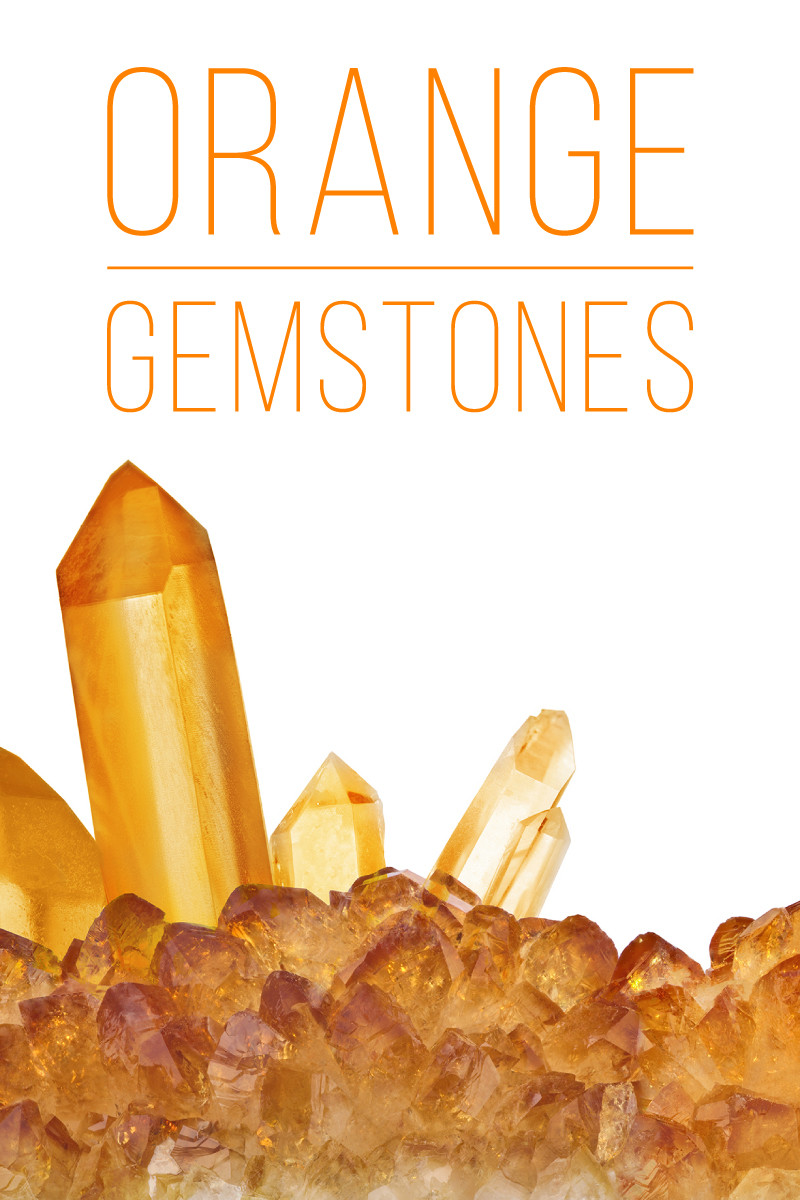 Colored gemstones offer a peek into nature’s wonders, as well as spiritual ties to particular hues, from passionate red to royal purple. But what about the warm and radiant orange crystals and stones? What type of gemstones are orange?
Colored gemstones offer a peek into nature’s wonders, as well as spiritual ties to particular hues, from passionate red to royal purple. But what about the warm and radiant orange crystals and stones? What type of gemstones are orange?
We’ll go over all orange gemstone names and meanings today, including:
Orange Gemstones
Amber
Andesine Feldspar
Carnelian
Citrine
Sunstone
Coral
Fire Opal
Orange Garnets
Orange Sapphires
Imperial Topaz
Tangerine Quartz
Orange Calcite
Orange Moonstone
Orange Zircon
Orange Spinel
Orange Tourmaline
Orange Aventurine
Orange Fluorite
Orange Jasper
Sardonyx
Orange Kyanite
Orange Jade
Orange Diamond
Before we take a closer look at these stones, what symbolism and healing properties are behind the orange gemstone meaning?
Orange crystals channel excitement, as they symbolize happiness, creativity, and stimulation. Many orange healing crystals can provide support during difficult transitions, encouraging hope and personal growth. And, most orange gemstones balance the sacral and solar plexus chakras!
With that in mind, let’s get into our list of orange crystal types, along with their meanings and healing properties. To start: what gemstones are orange brown?

Amber
Amber is a brownish-orange gemstone formed by ancient trees. When these trees experience wounds, they create a resinous material (amber) that hardens and seals the injury. Amber is typically translucent and may be yellow, orange, or brown.
Amber has held religious and spiritual associations since the age of dinosaurs. The classical name for amber was elektron, meaning “made by the sun.” Unsurprisingly, amber is a zodiac stone for the sun-ruled sign Leo and a solar plexus chakra stone.
Ancient Greek mythology incorporated amber into the myth of Phaeton. Phaeton, son of the sun god Helios, died while recklessly driving Helios’ chariot too close to Earth. Phaeton’s sisters mourned and turned into poplar trees, their tears becoming amber.

Andesine Feldspar
Andesine feldspar, or simply andesine, is a plagioclase feldspar mineral with vibrant honey red, red-orange, or yellow coloring. Copper inclusions cause the various hues.
Some call andesine red labradorite, but labradorite has a different composition. However, andesine may show subtle labradorescence, an optical effect where the inside of a stone reflects flashes of color.
Andesine is sometimes color-changing, with shifts from emerald green to orange-red hues comparable to alexandrite. Metaphysically, andesine is a heart chakra stone and has grounding and stress-relieving properties.
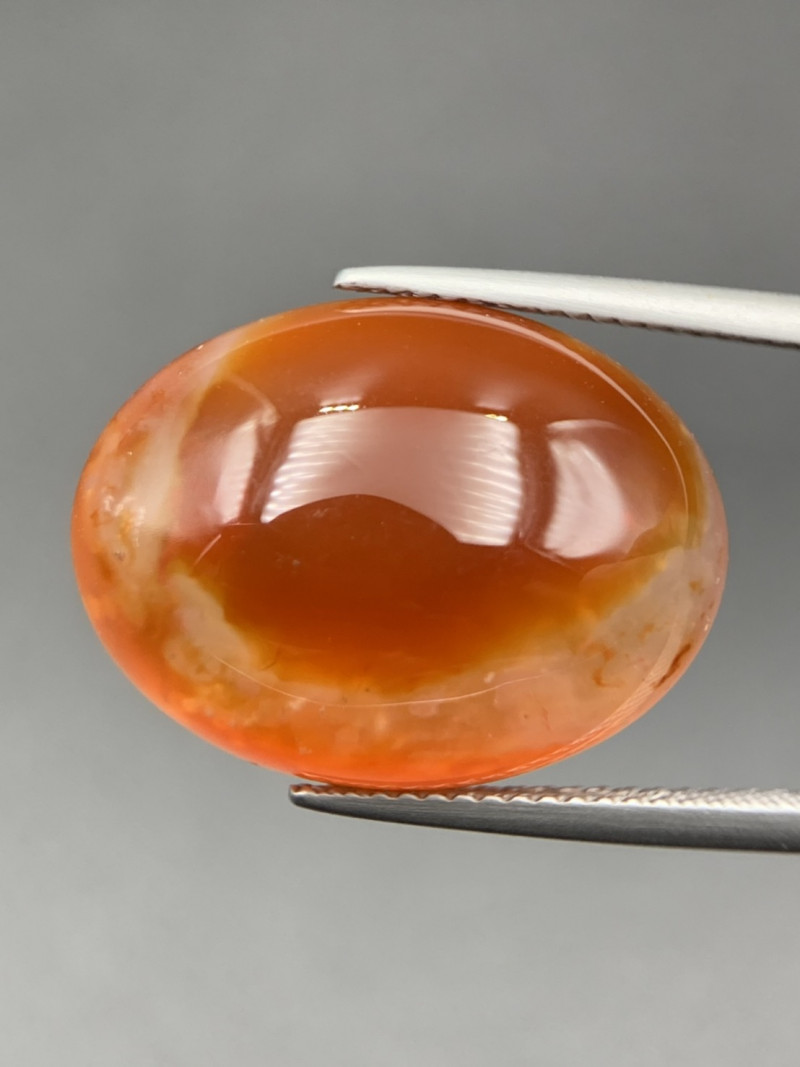
Carnelian
Carnelian is a chalcedony variety ranging from pink-orange to red-orange to orange-brown, though most people associate it with vivid red-orange hues. Iron oxide causes carnelian’s colors, so heavy exposure to sunlight can make your carnelian crystal darker and redder as the iron turns to rust.
Carnelian is nicknamed the “Stone of Creativity — ” an artist's ideal gemstone. Egyptians called carnelian “the setting sun” after its coloring.
In Islam, carnelian is one of the most sacred gemstones. The prophet Muhammad reportedly wore a carnelian in a signet ring. Those born in August can also wear carnelian as their traditional birthstone!
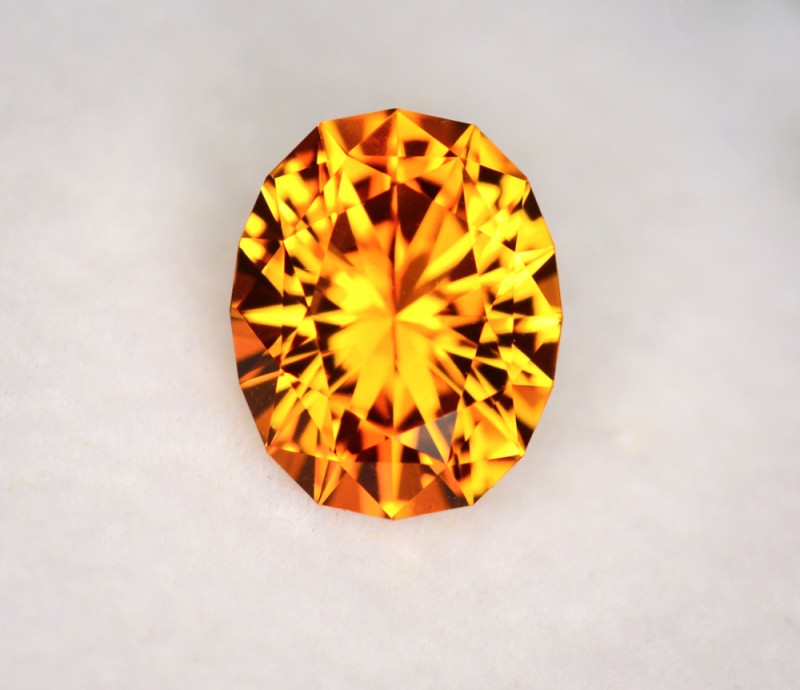
Citrine
Citrine is a yellow, orange, or cognac-hued quartz gemstone. Certain varieties, like Madeira citrine, show deep orange coloring. Its color comes from iron, with larger amounts leading to redder or reddish-brown hues.
Citrine has impurities affecting its color, and many darker citrine stones are actually heat-treated amethyst. The most valuable citrine crystals show saturated, warm yellow-orange tones, though you can find more affordable specimens in pale yellow hues.
Ancient Romans believed citrine could ward off negative thoughts. So, they carved the stone into Bonus Eventus, a divine representation of good fortune.
Nicknamed the “Success Stone,” this orange-yellow gemstone is known for manifesting abundance, wealth, and achievement. Citrine also symbolizes joy, optimism, and self-expression. This gem is a November birthstone, as well as the traditional gemstone for 13th wedding anniversaries.
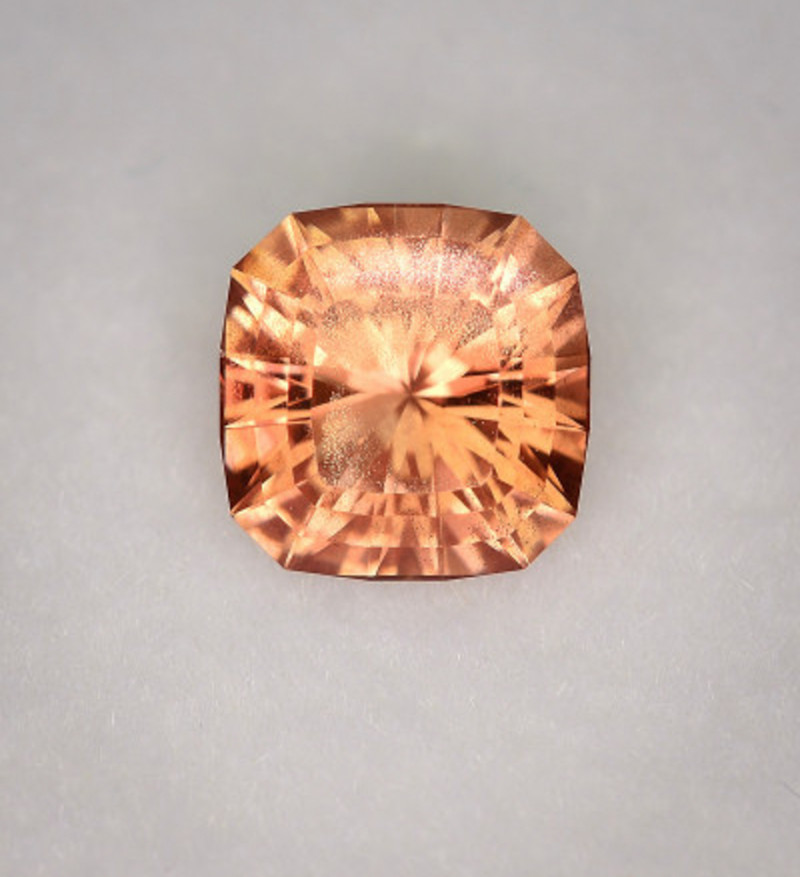
Sunstone
Sunstone is a labradorite feldspar variety with an orange, yellow, or brown base color and a red to golden shimmering surface. Inclusions like hematite or goethite cause sunstone’s metallic shimmer, or “schiller.”
Oregon Sunstone is a yellow, peach, or reddish-orange sunstone variety often regarded as the best type of sunstone. Oregon sunstones are the only sunstones containing copper inclusions, which gives them their color and aventurescence (metallic sparkle.) Some Oregon sunstones show different color shades throughout the stone, usually darkest towards the center and paler near the edges.
Sunstone started as a nickname for aventurescent labradorites for their resemblance to bright sunlight flashes. Fittingly, sunstone symbolizes warmth, life, and joy. Plus, sunstone is a birthstone for summer months July and August!
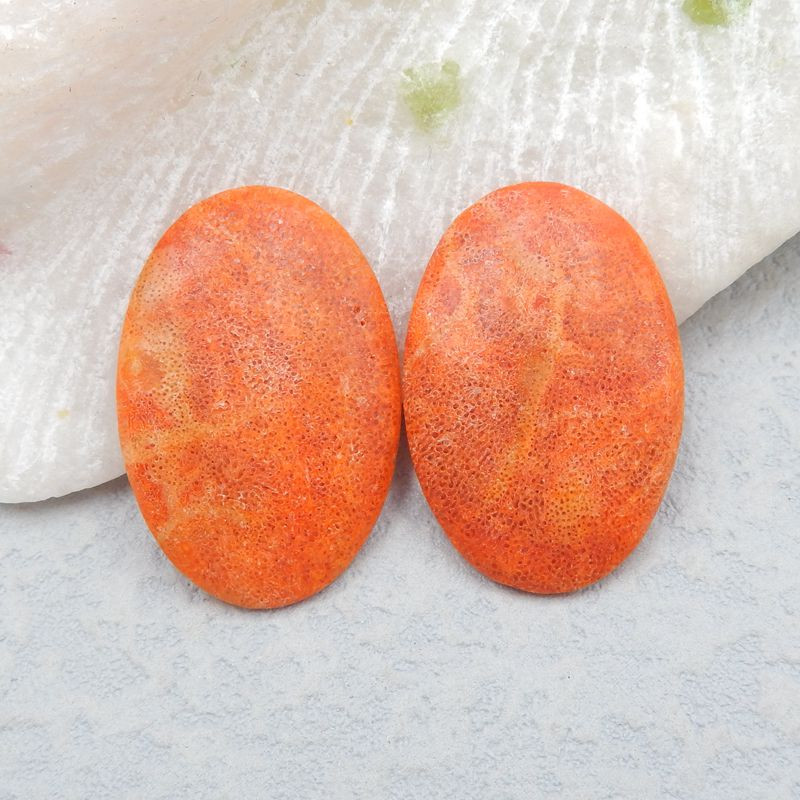
Coral
Coral is an organic, amorphous gemstone composed of the branching exoskeletons shed by coral polyps. Most coral is white, but red coral is the most popular gemstone form. Red coral, or precious coral, can display various hues, from deep red to pale pink or pinkish-orange.
The color “coral” was named after the gem’s pinkish-orange hues. On the Mohs mineral hardness scale, coral ranks between 3-4, making it a delicate gemstone.
Coral may go by “Mars stone” as it’s commonly associated with the planet Mars and the zodiac sign Aries. Coral is also an alternative gemstone for 35th wedding anniversaries and a healing crystal for balancing the sacral chakra.

Fire Opal
Fire opal is an orange opal variety, though its body tones are red, orange, and/or yellow. These opals are unique in being translucent to transparent and commonly faceted. The only prominent sources of gem-quality fire opals are Mexico and Ethiopia.
Mexican fire opals get their brilliant red-orange coloring from iron oxide and the way light reflects off their internal structure. While Mexican fire opals are typically common opals, Ethiopia produces precious fire opals, meaning they show play-of-color.
The play-of-color in Ethiopian fire opals, or Welo opals, can flash in bright purples and greens. These opals are hydrophane, meaning they can absorb water, and water submersion or humidity can alter their color.
Ancient peoples believed the fire opal’s flame-like colors meant the stones came from waters of paradise. Fittingly, the Aztecs and Mayans named the fire opal Quetzalitzlipyollitli, or “Stone of the Bird of Paradise.”
The opal is the traditional October birthstone and the traditional gift for the 14th wedding anniversary. Crystal healers use opals to attract abundance, increase intuition, and promote creativity.
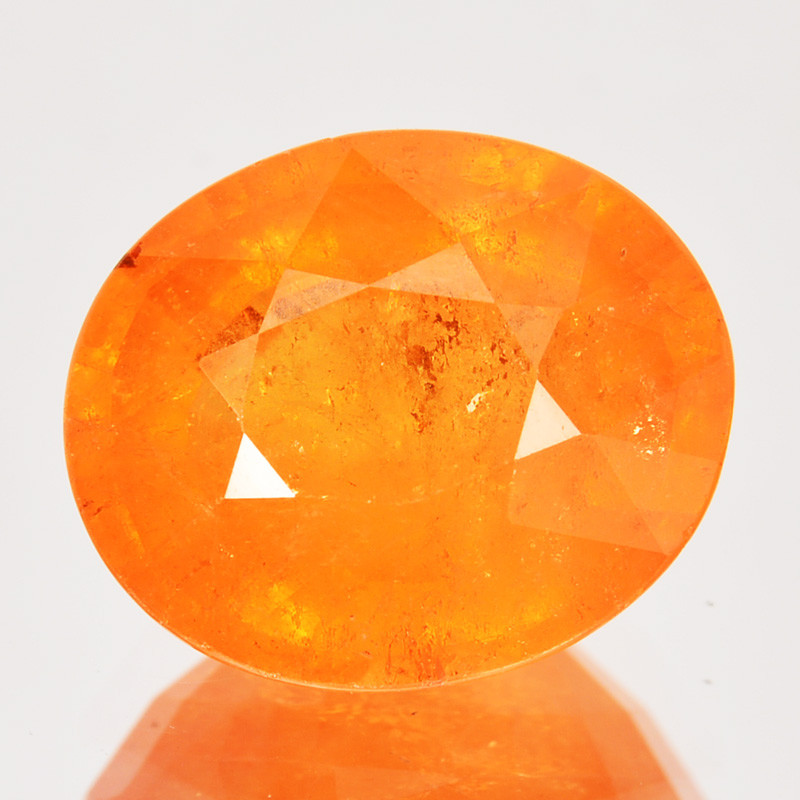
Orange Garnets
Garnet has two notable orange varieties: spessartite and hessonite.
Mandarin garnet is a trade name for spessartite, which ranges from bright mandarin orange to deep brownish-red. Spessartite is idiochromatic, meaning its color comes from elements in its chemical formula, and its characteristic orange comes from the chemical manganese.
Hessonite garnet is a yellow-orange to burnt orange grossular garnet. Compared to spessartite garnet, this darker orange crystal’s identification comes down to inclusions. Hessonite garnets usually contain apatite crystal inclusions, giving their interior a roiled appearance like moldavite.
New-Years babies might recognize garnet as the traditional January birthstone! Astrologically, garnets are zodiac stones for Capricorn and Aquarius. These crystals symbolize passion, commitment, and understanding.
Up next, what stone is orangish-red?
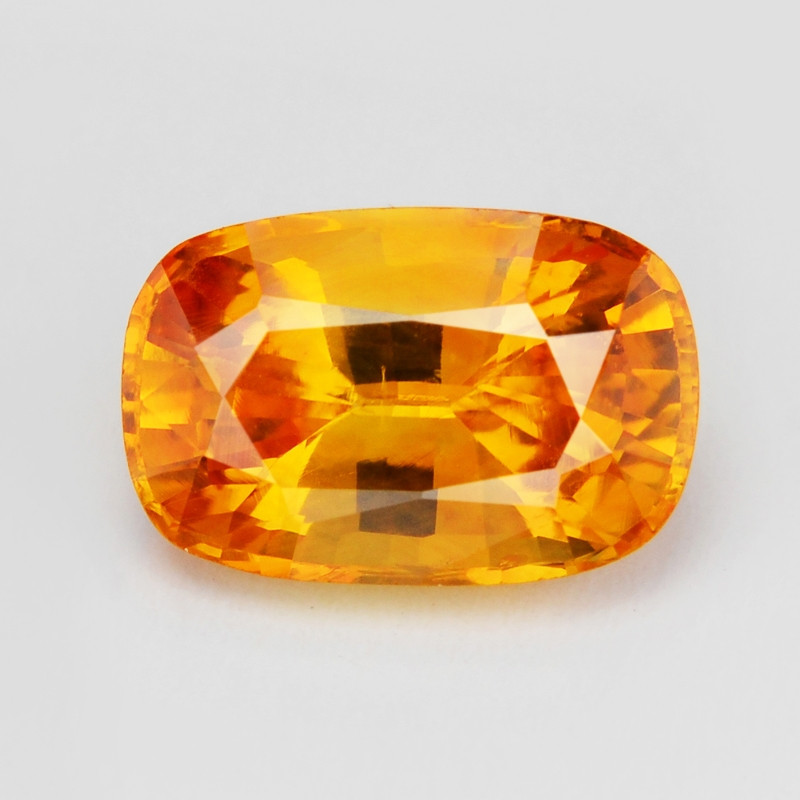
Orange Sapphires
Orange sapphire is the rarest color of sapphire, displaying pale orange to deep orange-red hues all caused by traces of vanadium. Most sapphires have strong pleochroism, which means they display different colors from different angles. These gems shift from yellowish-brown to orange or even to a colorless hue!
An even higher-valued orange sapphire is the Padparadscha sapphire, a pink-orange variety named after the ancient Sanskrit word for a sacred lotus flower with similar coloring.
Speaking of the sacred, ancient Greeks wore sapphire when visiting the prophetic Oracle of Delphi and clergymen, and nobles wore sapphire rings as heavenly forms of protection. Today, sapphire is a September birthstone and a Taurus zodiac stone. Golden-orange sapphires are often called “Stone of Spiritual Power” and “Stone of Abundance and Creativity.”
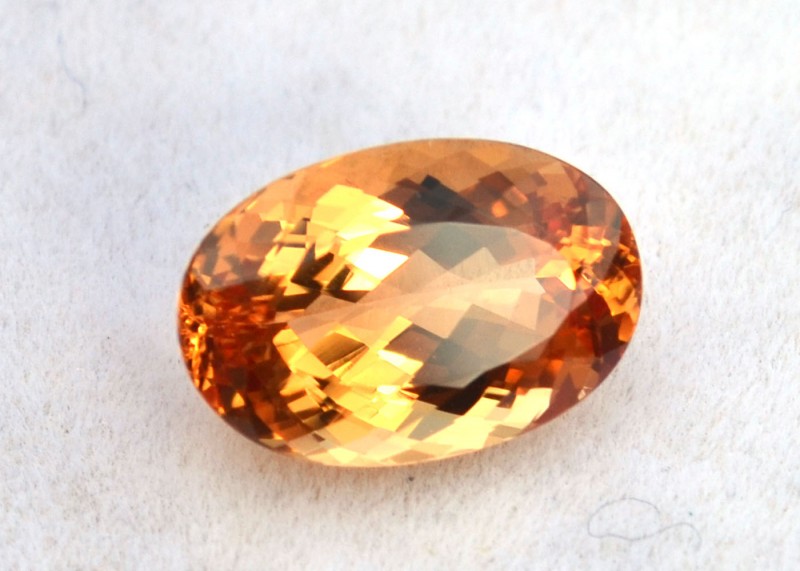
Imperial Topaz
Imperial topaz is a rare golden-orange, reddish-orange, or pink-orange stone known as the most valuable form of topaz. Usually, the imperial topaz has an orange base with pink undertones. But, some gemologists claim only those with a yellowish-orange body tone and red pleochroism are true imperial topaz.
Topaz is allochromatic, and orange colors occur from irradiation-induced color centers and chromium impurities. Other orange topaz varieties include whisky topaz and sherry topaz, and the US state of Utah honors orange topaz as their official state gemstone.
The Christian Bible calls topaz the “Stone of Fire,” and even the name topaz comes from the Sanskrit word tapas, meaning “fire.” Topaz is also a zodiac stone for fire sign Sagittarius, as well as the traditional November birthstone.

Tangerine Quartz
Tangerine quartz is a pale yellow to rust-orange quartz variety named for its resemblance to its eponymous orange fruit. It may also go by “sunfire” or “orange quartz.” Geologically, this stone is a hematoid quartz, meaning quartz included or coated with hematite.
The stone’s physical formation brings about its color, where nearby water causes the iron-oxide mineral hematite to rust, bonding to clear quartz and giving it an orange coating. This orange coating is delicate, so you shouldn't polish it or bathe it in acid — or else you'll remove the quartz's orange color!
Tangerine quartz symbolizes curiosity, inspiration, and childlike joy. You can use the crystal’s healing properties for higher confidence and clarity, as well as for opening your sacral and solar plexus chakra. The zodiac signs tied to tangerine quartz are sunny-dispositioned Leo and Libra.
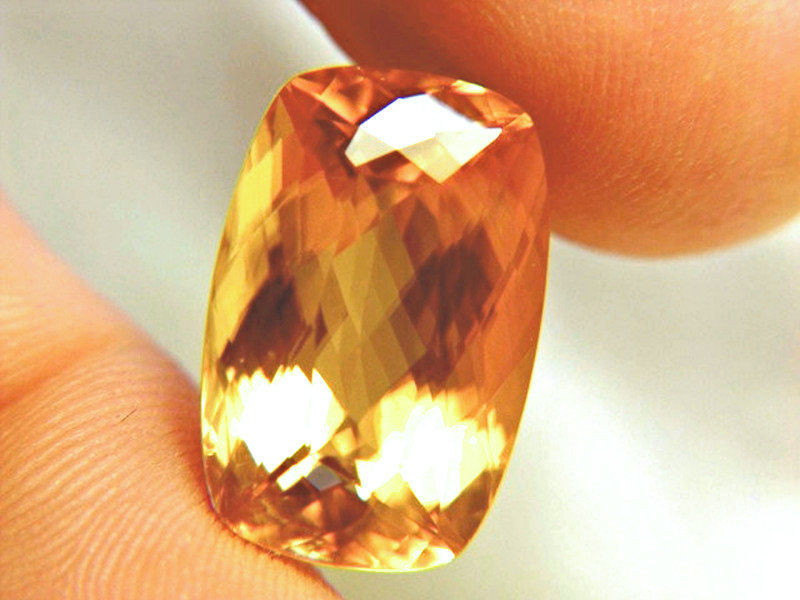
Orange Calcite
Orange calcite displays shades of honey, orange, amber, and orange-red. Pure calcite is colorless, so orange calcite’s shades come from tiny hematite inclusions that reflect orange light. The stone only ranks at 3 on the Mohs scale, so it’s better for earrings or pendants.
Calcite is an abundant calcium carbonate mineral with a myriad of industrial and decorative uses. However, you’ll usually find it as the primary ingredient in marble and limestone. Calcite comes from the Latin calx, for “lime,” and people throughout history used calcite, from the Egyptians who built the Great Pyramids of Giza to Michelangelo’s sculptures.
Symbolically, orange calcite represents personal growth and fulfillment. Healing uses include stability during big changes and converting ideas into reality. Cancer astrological signs can use orange calcite as a zodiac stone as well!
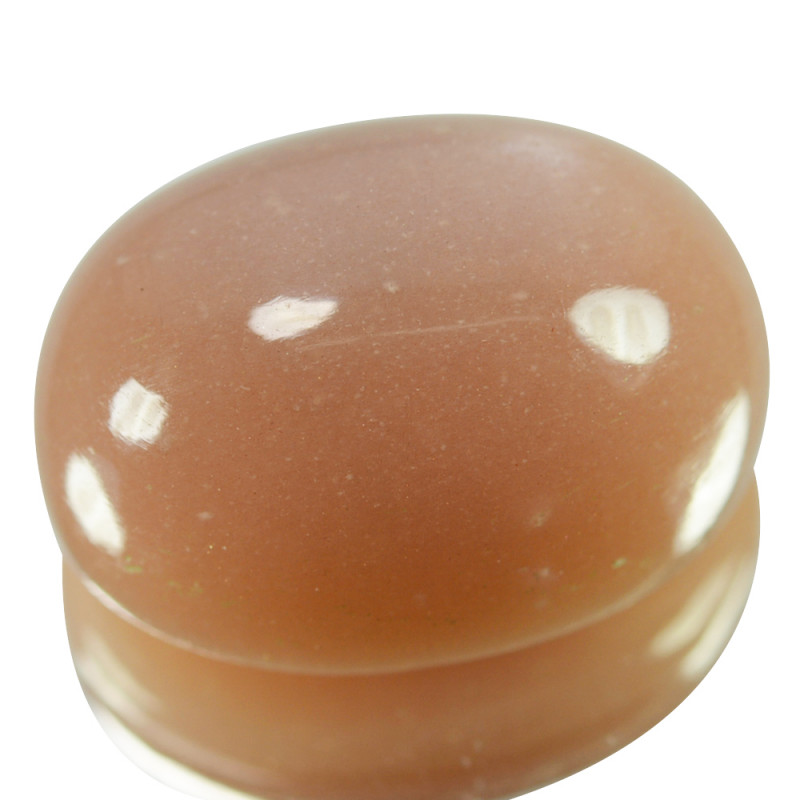
Orange Moonstone
Orange moonstone is an orthoclase feldspar variety in soft peach to bright orange hues caused by iron inclusions. Like all moonstone crystals, this gem glows in a white to a blue hue, an optical phenomenon called adularescence. Orange is rare to see in moonstones, and transparent saturated specimens command high prices.
Other moonstones with orange coloring include the pale pink-orange type called peach moonstone and rainbow moonstones, which display green and orange coloring but are technically labradorite, not moonstone.
Moonstone is the moon’s planetary stone, making it beneficial for any Cancer zodiac sun, moon, or rising. This gem is also a June birthstone and connects to various lunar goddesses. Ancient Romans believed moonstones came from Diana, goddess of the moon, while ancient Indians connected the crystals to their moon goddess, Chandra.
Orange moonstone symbolizes fulfillment, harmony, and hope, earning the nickname “Stone of New Beginnings.” Healing-wise, this orange stone can balance the sacral and third eye chakras. It's also known for attracting romance!

Orange Zircon
Orange zircon is a semi-precious gemstone in red-orange, honey, and champagne colors. Zircon is unique in containing tiny amounts of radioactive elements that break down very slowly (over thousands of years) to create new colors like orange!
Tanzania boasts beautiful rose-orange zircons, while Cambodia is known for its earthy orange to brownish-orange zircon stones. All orange zircons fluoresce in yellow and orange, except for:
red-orange specimens, which only glow in short-wave UV light; and
yellow-orange specimens, which glow in short-wave and long-wave UV light.
Gemologists sometimes use the term hyacinth or jacinth for transparent zircons with orange, yellow, or red hues. “Zircon” actually comes from the Persian zargun for “golden-colored.” Yellowish-orange zircons may be called the “Stone of Prosperity” for their purported ability to manifest wealth.

Orange Spinel
Spinel is an isometric oxide with flame orange specimens coming from Tanzania and Burma. Burmese orange spinels are vibrant, red-orange stones with the trade name “flame spinel.” Tanzanian orange spinel is rarer, more often acting as an undertone to red spinel. Microelement chromium traces are typically behind the orange coloring.
Orange spinels have subtle red to red-orange fluorescence in short-wave UV light and stronger fluorescence in long-wave UV light. At an 8 on the Mohs scale, these make for a durable orange gemstone ring!
Orange spinel crystals represent rejuvenation, joy, and hope. Historically, people mistook spinels for rubies until the late 1700s. One famous example is the Imperial Crown of the Austrian Empire, which features a deep red-orange spinel center stone.

Orange Tourmaline
Orange tourmaline may be pink-orange, brownish-orange, or honey-colored and is not a common tourmaline color to find. Typically, these stones are from the dravite species of tourmaline and get their hue from a charge transfer between iron and titanium.
Some hues of orange tourmaline, particularly those with strong pink or yellow undertones, come from manganese or irradiation. When the type or concentration of trace elements shift during the stone’s formation, you may see color-zoning.
These are some of the best orange crystals to provide protection, aid the nervous system, and boost empathy. In that vein, orange tourmaline symbolizes open-mindedness, positivity, and creativity. Those with October birthdays already have tourmaline as their traditional birthstone, so why not go full Halloween mode with orange?

Orange Aventurine
When aventurine stones have small hematite or goethite inclusions, they can produce wonderful orange hues. Lower amounts of these inclusions can produce muted brownish-orange stones, while higher concentrations lead to saturated bright orange or peach specimens.
Aventurine itself is a unique quartz variety composed of both chalcedony and feldspar. The term “aventurescence” comes from this stone’s signature glittering surface caused by its various microscopic inclusion flakes.
Ancient Chinese people believed aventurine symbolizes kindness and forgiveness. So, they associated the stone with the Buddhist deity Kuan-Yin. Nowadays, crystal users turn to orange aventurine for its empowering and grounding properties. These features are quite fitting for a grounded Earth zodiac sign. You guessed it! Taurus zodiac signs can use orange aventurine as a lucky talisman!
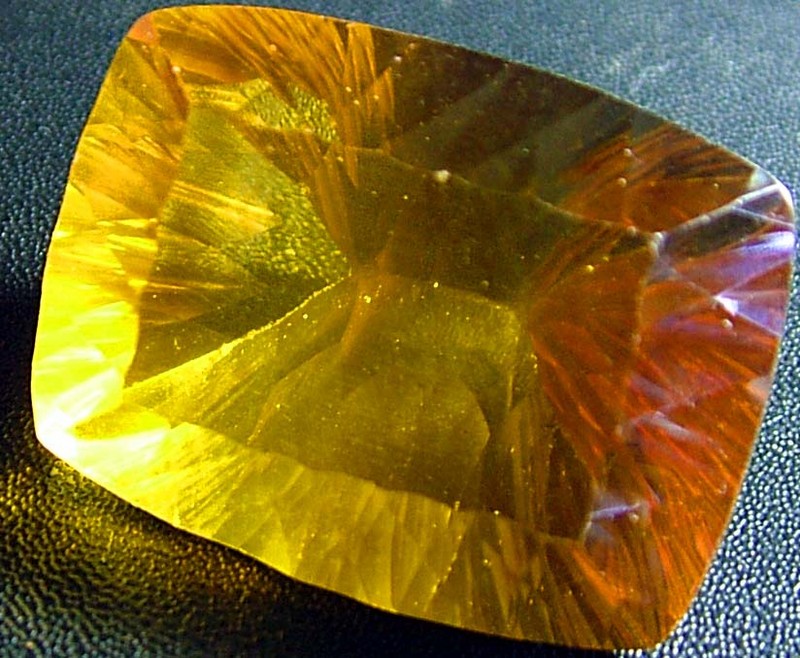
Orange Fluorite
Another gemstone of many colors, orange fluorite comes in deep whiskey orange, pale yellow-orange, and terracotta orange. You can thank fluorite's internal structure, as well as manganese ions for fluorite’s orange shades.
At a microscopic level, the chemicals in fluorite crystals bond in a regular, repeated pattern called a lattice structure. Different colors appear when either:
the lattice pattern is defective;
the stone undergoes natural irradiation; or
impurities enter the stone during formation.
Orange fluorite healing crystals can provide mental clarity, increase energy, and help navigate negative emotions. These yellowish orange crystals symbolize unity, wisdom, and fulfillment. Plus, anyone with a Capricorn or Pisces zodiac sign is graced with fluorite as their zodiac stone!
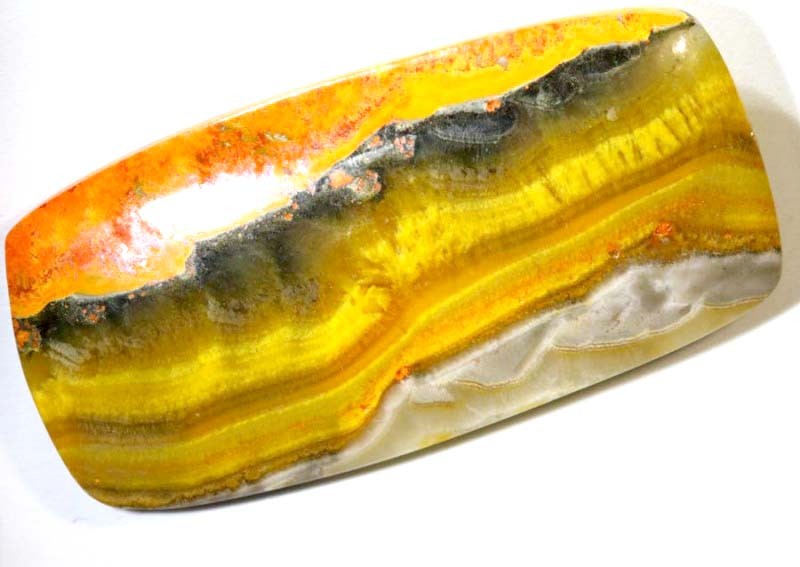
Orange Jasper
Jasper is a type of opaque chalcedony with dozens of earth-toned varieties. Most jaspers show intricate multi-colored patterns. The name jasper actually comes from the Old French jaspre, meaning “spotted (or speckled) stone.” Plenty of varieties have orange coloring, including:
Noreena Jasper: Noreena Jasper is an Australian variety with red, orange, yellow, and white patterns resembling an acrylic-pour painting.
Carrasite Jasper: A motley mixture of orange, yellow, forest green, red, and brown swirl across the surface of carrasite jasper.
Bumblebee Jasper: Though not technically jasper but agate, this variety has orange, yellow, and black stripes.
Orbicular Jasper: Though its colors vary, orbicular jasper’s pattern of interconnected spheres comes in rusty orange hues mixed with reds and browns.
Flame Jasper: Flame jasper is a type of picture jasper with red and orange swirls.
Known as the “Supreme Nurturer,” jasper stones represent reassurance and tranquility. This orange gem is a lucky zodiac stone for Virgo and a birthstone for March!

Sardonyx
While jasper is an opaque chalcedony, agate is any translucent chalcedony. Sardonyx is an agate variant made of chalcedony and onyx layers that create banded lines in orange, white, red, and black.
Ancient Romans made sardonyx carvings to invite romance with a cameo of Venus (goddess of love) or to manifest victory with a carving of Ares, god of war.
August babies are lucky enough to claim sardonyx as one of their three birthstones. And, Aries and Leo zodiac signs are graced with a sardonyx zodiac stone as well. You can use this orange white gemstone to:
protect yourself from malevolent forces;
improve your strength; and
increase your self-confidence.
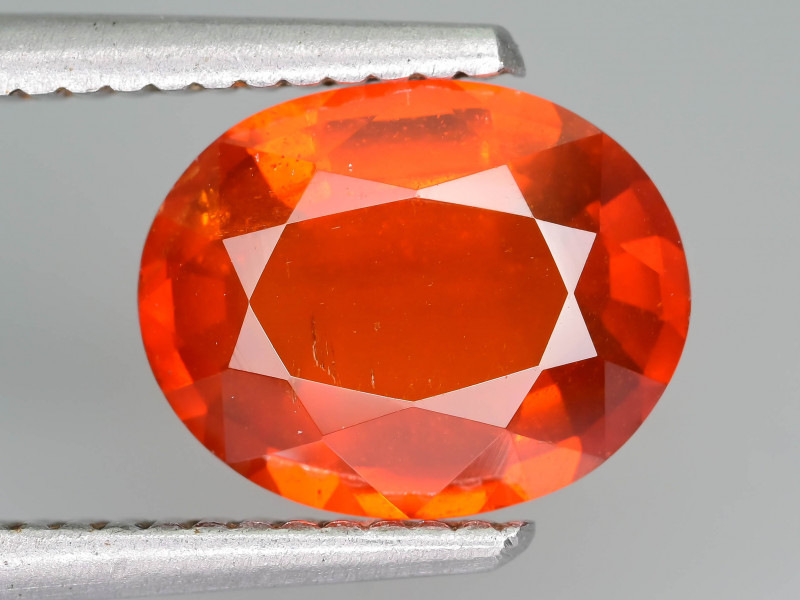
Orange Kyanite
Orange kyanite is a fibrous, golden-orange to golden-brown type of kyanite colored via traces of manganese. This color is the rarest form of kyanite and fairly new, as Tanzania only uncovered orange kyanite deposits in 2008.
Kyanite is an aluminum silicate, though you may hear “disthene” or “rhaeticite” used to describe the stone. It’s hardness is unusual, as one axis is 4.5 to 5 on the Mohs scale, while the opposite axis is 6.5 to 7.
Orange kyanite has spiritual benefits like aiding psychic ability and lucid dreaming. Emotionally, these dark orange crystals can aid in communication, intuition, and healing deep-set emotional wounds. Orange kyanite stones are best for balancing the sacral chakra.

Orange Jade
The term “jade” refers to two stones: jadeite and nephrite. While both are similar in appearance, only jadeite comes in orange hues, from pale apricot to rich red-orange. The stone’s color and transparency are caused by inclusions and the rate of cooling during formation.
Jade stones symbolize acceptance and protection, and orange jade specifically represents unity and happiness. Healing properties include healing heartache, stimulating the mind, and promoting unconditional love. Jade is also the traditional gift for the 12th wedding anniversary, along with a zodiac stone for Taurus and Libra.
As we reach the end, what is the most expensive orange gem?

Orange Diamond
Last on our list is the king of gemstones: diamond! Orange diamonds rank #1 in monetary value, commanding prices in the millions.
Orange diamonds are often called “pumpkins” for their resemblance in color to the fall vegetable. Formed naturally, nitrogen impurities cause the pumpkin hues. However, many orange diamonds are synthetically colored to meet demand.
The largest Fancy Vivid Orange diamond, as named by the Gemological Institute of America, clocks in at 14.82 cts. The stone, nicknamed “the Orange,” auctioned for a whopping $35.5 million!
These orange gemstones symbolize bravery, enthusiasm, and vigor. If you’re an April baby looking for a show-stopping accessory, spice up your birthstone with a fiery color!
Which Orange Gem Is Most A-Peeling?
While orange is a rarer color to see in gemstones, you can see there are plenty of gorgeous specimens to choose from. Even rarer stones like petrified palm wood, aragonite, bastnasite, triplite, scheelite, and clinohumite come in orange hues.
If you’re ready to feel some nurturing warmth and get your creative juices flowing, find your favorite orange gemstone today!
Search the Gemstone Encyclopedia
Related Auctions
Related Articles
Everyone has a gemstone that corresponds with their star sign. These are also known as your Star Stone. Learn more about these stones and find out what your Star Stone is.
10th May 2018
Originally the Birthstones or gemstones were associated with a zodiac sign or the month of a individuals birth. Find out what your stone is and view the stones we have for sale
8th Feb 2021
There are so many tools on the market for testing a gemstone, but what are the main tools required for simple analysis. Lets look at four tools for gemstone testing.
4th Mar 2020
Latest Articles
Yugawaralite is a rare colorless, white, or pinkish zeolite crystal named for its discovery in Yugawara, Japan. Here we uncover the multifaceted history, properties, prices, and uses of yugawaralite.
24th Mar 2025
Simpsonite is a lesser-known mineral known on the gem market for its durability, yellow-orange color, and rarity. Discover all the properties, uses, prices, and history of simpsonite.
3rd Mar 2025
Kurnakovite is a colorless crystal related to inderite and rarely faceted but known among collectors. Explore the mineral traits, history, prices, and more in this kurnakovite guide.
17th Feb 2025
Article Categories
How To's is where you will find helpful articles from gem Rock Auctions on how to cut gemstones, select gemstones and buy gemstones.
9 Articles








